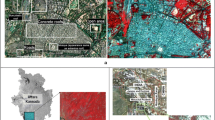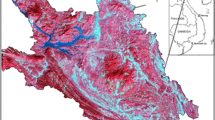Abstract
The main objective of this research is to determine the capacity of land cover classification combining spectral and textural features of Landsat TM imagery with ancillary geographical data in wetlands of the Sanjiang Plain, Heilongjiang Province, China. Semi-variograms and Z-test value were calculated to assess the separability of grey-level co-occurrence texture measures to maximize the difference between land cover types. The degree of spatial autocorrelation showed that window sizes of 3×3 pixels and 11×11 pixels were most appropriate for Landsat TM image texture calculations. The texture analysis showed that co-occurrence entropy, dissimilarity, and variance texture measures, derived from the Landsat TM spectrum bands and vegetation indices provided the most significant statistical differentiation between land cover types. Subsequently, a Classification and Regression Tree (CART) algorithm was applied to three different combinations of predictors: 1) TM imagery alone (TM-only); 2) TM imagery plus image texture (TM+TXT model); and 3) all predictors including TM imagery, image texture and additional ancillary GIS information (TM+TXT+GIS model). Compared with traditional Maximum Likelihood Classification (MLC) supervised classification, three classification trees predictive models reduced the overall error rate significantly. Image texture measures and ancillary geographical variables depressed the speckle noise effectively and reduced classification error rate of marsh obviously. For classification trees model making use of all available predictors, omission error rate was 12.90% and commission error rate was 10.99% for marsh. The developed method is portable, relatively easy to implement and should be applicable in other settings and over larger extents.
Similar content being viewed by others
References
Bolstad P V, Lillesand T M, 1992. Rule-based classification models: flexible integration of satellite imagery and thematic spatial data. Photogrammetric Engineering and Remote Sensing, 58(7): 965–971.
Breiman L, Friedman J H, Olshen R A et al., 1984. Classification and Regression Trees. Boca Raton, FL: Chapman & Hall.
Chavez P S, 1988. An improved dark-object substraction technique for atmospheric scattering correction of multispectral data. Remote Sensing of Environment, 24(3): 459–479. DOI: 10.1016/0034-4257(88)90019-3
Clark L A, Pregibon D, 1992. Tree-based models. In: Chambers et al. (eds.). Statistical Models. Pacific Grove, CA: Wadsworth & Brooks/Cole, 377–419.
Congalton R G, Green K, 1999. Assessing the Accuracy of Remotely Sensed Data: Principles and Practices. Boca Raton, FL: CRC Press.
Ernst C L, Hoffer R M, 1979. Digital processing of remotely sensed data for mapping wetland communities. West Lafayette: Laboratory for Applications of Remote Sensing, Purdue University.
Franklin S, Wulder M, Lavigne M, 1996. Automated derivation of geographic windows for use in remote sensing digital image analysis. Computers and Geosciences, 22(6): 665–673. DOI: 10.1016/0098-3004(96)00009-X
Hansen M, Dubayah R, Defries R, 1996. Classification trees: An alternative to traditional land cover classifiers. International Journal of Remote Sensing, 17(5): 1075–1081. DOI: 10.1080/01431169608949069
Hinson J M, German C D, Pulich W J, 1994. Accuracy assessment and validation of classified satellite imagery of Texas coastal wetlands. Marine Technology Society Journal, 28(2):4–9.
Huete A, Didan K, Miura T et al., 2002. Overview of the radiometric and biophysical performance of the MODIS vegetation indices. Remote Sensing of Environment, 83(1–2): 195–213. DOI: 10.1016/S0034-4257(02)00096-2
Jensen J R, Hodgson M, Christensen E et al., 1986. Remote sensing of inland wetlands: A multi-spectral approach. Photogrammetric Engineering and Remote Sensing, 52(1): 87–100.
Johansen K, Phinn S, 2006a. Mapping structural parameters and species composition of riparian Vegetation using IKONOS and Landsat ETM+ data in Australian tropical Savannahs. Photogrammetric Engineering and Remote Sensing, 72(1): 71–80.
Johansen K, Phinn S, 2006b. Linking riparian vegetation spatial structure in Australian tropical savannas to ecosystem health indicators: Semivariogram analysis of high spatial resolution satellite imagery. Canadian Journal of Remote Sensing, 32(3): 228–243.
Joy S M, Reich R M, Reynolds R T, 2003. A non-parametric supervised classification of vegetation types on the Kaibab National Forest using decision trees. International Journal of Remote Sensing, 24(9): 1835–1852. DOI: 10.1080/01431160210-154948
Laine A, Heikkinen K, Heikkinen M et al., 2002. Integrated management and monitoring of boreal river basins: An application to the Finnish River Siuruanjoki. Large Rivers, 13(3–4): 387–399.
Lillesand T M, Kiefer R W, Chipman J W, 2004. Remote Sensing and Image Interpretation. 5th edition. New York, USA: Wiley.
Liu Xingtu, 1995. Wetland and its rational utilization and conservation in the Sanjiang Plain. In: Chen Yiyu (ed.). Study of Wetlands in China. Changchun: Jilin Science and Technology Press, 108–117. (in Chinese)
Miller J, Franklin J, 2002. Modeling the distribution of four vegetation alliances using generalized linear models and classification trees with spatial dependence. Ecological Modelling, 157(2–3): 227–247. DOI: 10.1016/S0304-3800(02)00196-5
Mitsch W J, Gosselink J G, 1993. Wetlands. 3rd edition. New York, USA: Van Nostrand Reinhold.
Ozesmi S L, Bauer M E, 2002. Satellite remote sensing of wetlands. Wetlands Ecology and Management, 10(5): 381–402. DOI: 10.1023/A:1020908432489
Pal M, 2005. Random forest classifier for remote sensing classification. International Journal of Remote Sensing, 26(1): 217–222. DOI: 10.1080/01431160412331269698
Sader S A, Ahl D, Liou W S, 1995. Accuracy of Landsat TM and GIS rule-based methods for forest wetland classification in Maine. Remote Sensing of Environment, 53(3): 133–144. DOI: 10.1016/0034-4257(95)00085-F
Sesnie S E, Gessler P E, Finegan B et al., 2008. Integrating Landsat TM and SRTM-DEM derived variables with decision trees for habitat classification and change detection in complex neotropical environments. Remote Sensing of Environment, 112(5): 2145–2159. DOI: 10.1016/j.rse.2007.08.025
Shalaby A, Tateishi R, 2007. Remote sensing and GIS for mapping and monitoring land cover and land use changes in the Northwestern coastal zone of Egypt. Applied Geography, 27(1):28–41. DOI: 10.1016/j.apgeog.2006.09.004
Stehman S V, 1999. Estimating the Kappa coefficient and its variance under stratified random sampling. Photogrammetric Engineering and Remote Sensing, 62(4): 401–407.
Stehman S V, Wickham J D, Smith J H et al., 2003. Thematic accuracy of the 1992 National Land-Cover Data for the eastern United States: Statistical methodology and regional results. Remote Sensing of Environment, 86(3–4): 500–516. DOI: 10.1016/S0034-4257(03)00128-7
Stow D, Hope A, Boynton W et al., 1998. Satellite-derived vegetation index and cover type maps for estimating carbon dioxide flux for arctic tundra regions. Geomorphology, 21(3–4): 313–327. DOI: 10.1016/S0169-555X(97)00071-8
Wright C, Gallant A, 2007. Improved wetland remote sensing in Yellowstone National Park using classification trees to combine TM imagery and ancillary geographical data. Remote Sensing of Environment, 107(4): 582–605. DOI: 10.1016/j.rse.2006.10.019
Zar J H, 1984. Biostatistical Analysis, 2nd Edition. Englewood Cliffs: Prentice-Hall.
Zhang S Q, Na X D, Kong B et al., 2009. Identifying wetland change in China’s Sanjiang Plain using remote sensing. Wetlands, 29(1): 302–313.
Zhang S Q, Zhang J Y, Li F et al., 2006. Vector analysis theory on landscape pattern (VATLP). Ecological Modelling, 193(3–4): 492–502. DOI: 10.1016/j.ecolmodel.2005.08.022
Zhang Yangzhen, 1988. The genesis, properties and classification of marsh soil in Sanjiang Plain. In: Huang Xichou (ed.). Marsh Research in China. Beijing: Science Press, 135–143. (in Chinese)
Author information
Authors and Affiliations
Corresponding author
Additional information
Foundation item: Under the auspices of National Natural Science Foundation of China (No. 40871188), National Key Technologies R&D Program of China (No. 2006BAD23B03)
Rights and permissions
About this article
Cite this article
Na, X., Zhang, S., Zhang, H. et al. Integrating TM and ancillary geographical data with classification trees for land cover classification of marsh area. Chin. Geogr. Sci. 19, 177–185 (2009). https://doi.org/10.1007/s11769-009-0177-y
Received:
Accepted:
Published:
Issue Date:
DOI: https://doi.org/10.1007/s11769-009-0177-y




